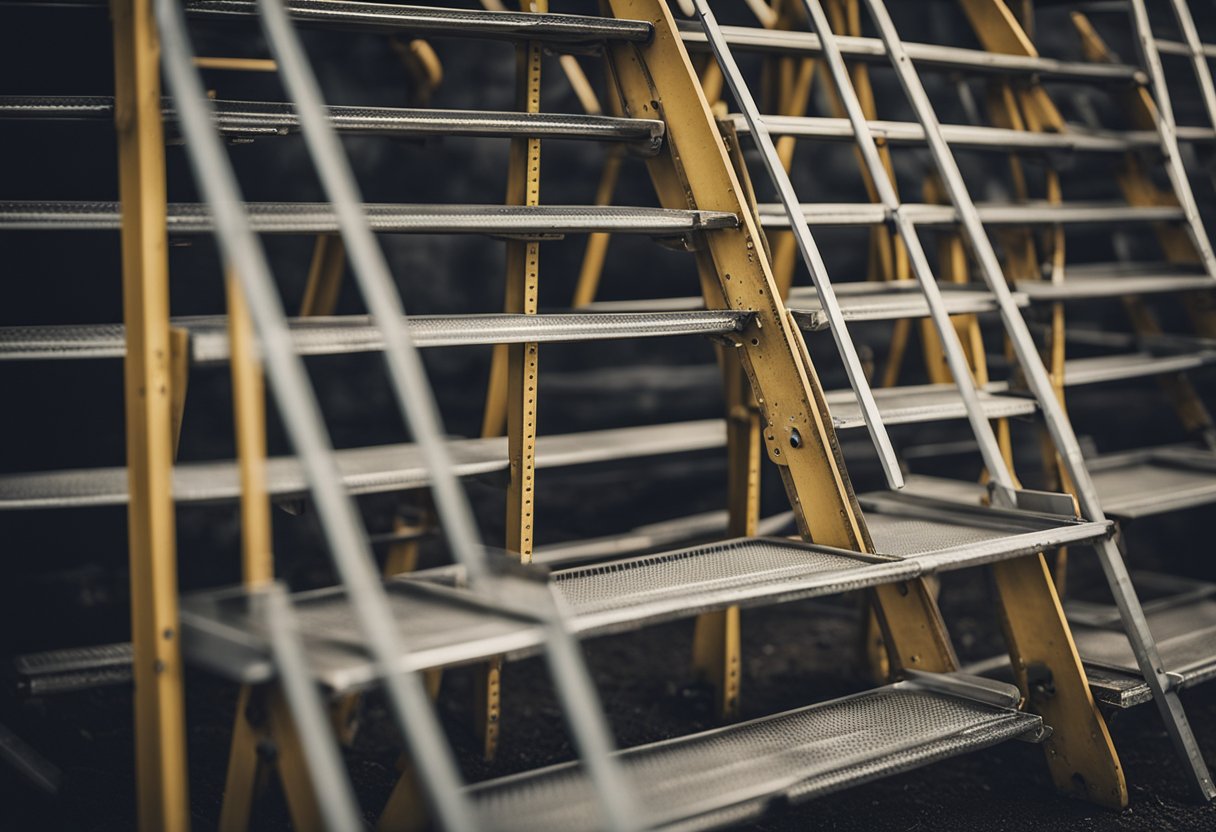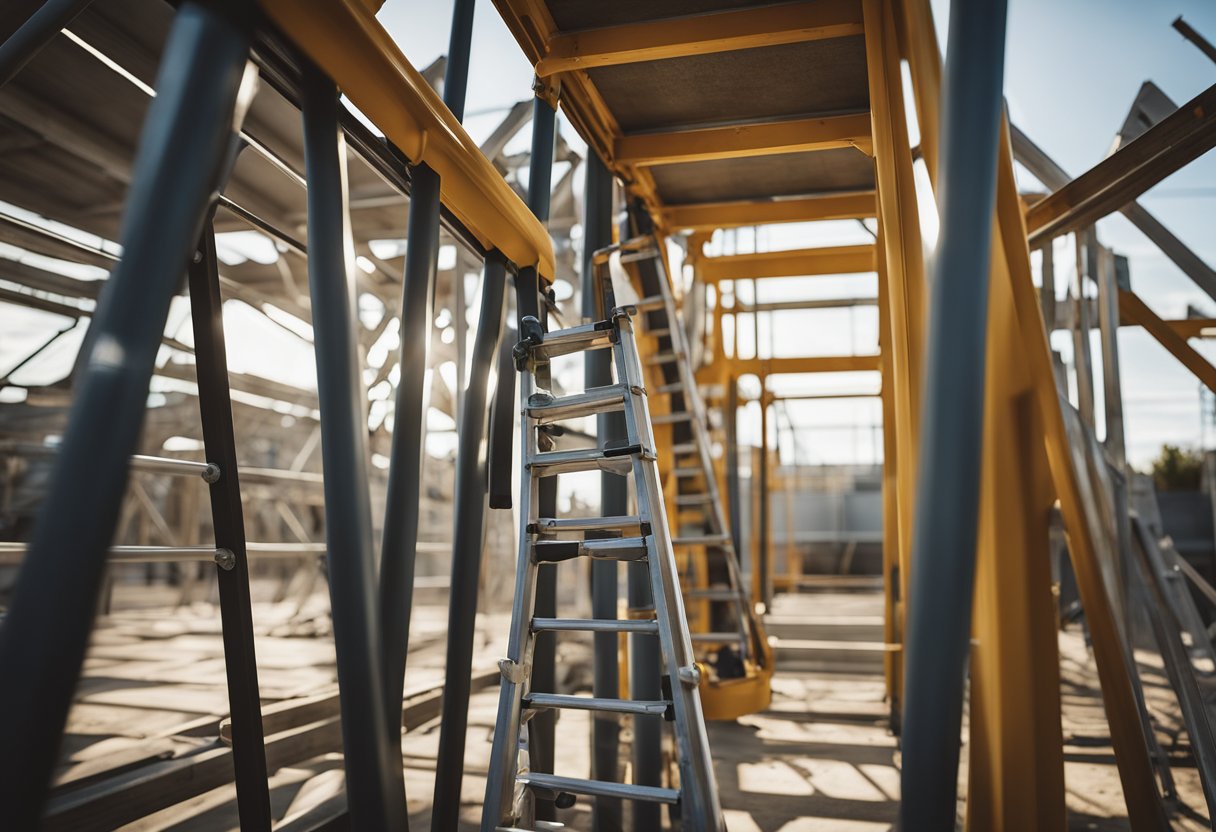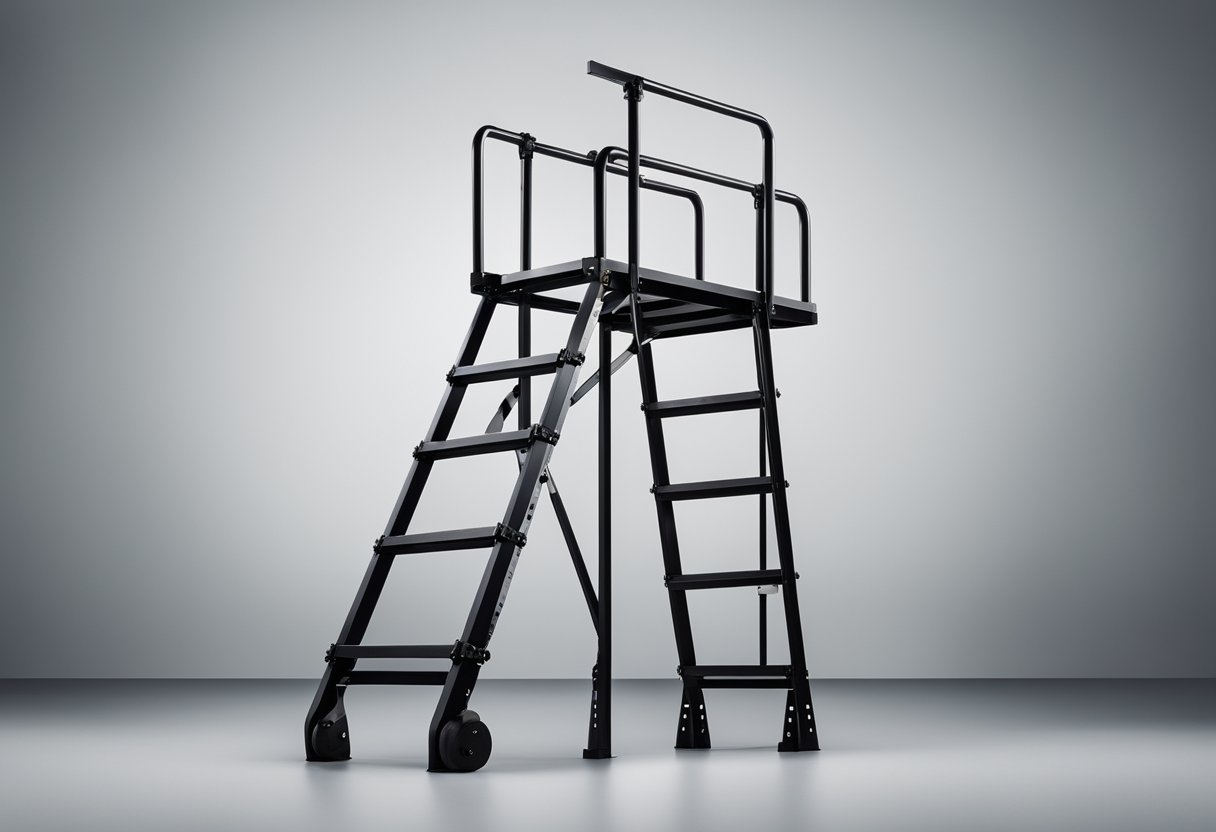As a homeowner or a professional contractor, you might need to use ladders frequently. Ladders are essential tools for various tasks such as painting, cleaning gutters, repairing roofs, and more. However, before using a ladder, it’s essential to know how much it weighs to ensure safety and stability. In this article, I will discuss how much ladders weigh and what factors affect their weight.

Understanding ladders is essential before discussing their weight. Ladders come in various types, sizes, and materials. The most common types of ladders are step ladders, extension ladders, and multi-position ladders. Each type has its unique features and uses. For example, step ladders are ideal for indoor use, while extension ladders are suitable for outdoor use. The weight of a ladder depends on the type, size, and material used in its construction.
Key Takeaways
- Ladders come in different types, sizes, and materials.
- The weight of a ladder depends on the type, size, and material used in its construction.
- Knowing the weight of a ladder is essential for safety and stability.
Understanding Ladders
https://www.youtube.com/watch?v=6oKQ_iXX0Lc&embed=true
As someone who has worked with ladders for years, I know that understanding the different types of ladders and their designs is crucial to using them safely and efficiently. There are many types of ladders available, each with unique features that make them suitable for different tasks.
A step ladder is a common type of ladder that is self-supporting, meaning it does not need to be leaned against a wall or other surface. They are often used for tasks such as changing light bulbs or reaching high shelves. Step ladders come in various sizes and styles, with some having a platform on top for additional stability.
Extension ladders, on the other hand, are designed to be leaned against a wall or other surface. They consist of two or more sections that can be extended to reach higher heights. Extension ladders are commonly used for tasks such as painting, cleaning gutters, or accessing rooftops.
Telescoping ladders are another popular type of ladder that can be extended and retracted to different lengths. They are highly versatile and can be used for a wide range of tasks, from changing light bulbs to accessing high attics.
Multipurpose ladders are designed to be used in various configurations, such as as an extension ladder, a step ladder, or even a scaffold. They are often used by professionals who need a ladder that can adapt to different tasks.
Platform ladders are another type of ladder that has a large, flat top for standing on. They are commonly used in industrial settings, such as warehouses or factories.
When it comes to ladder design, there are many factors to consider, including the material the ladder is made from, its weight capacity, and any additional features it may have. For example, some ladders have non-slip feet to prevent them from slipping on slick surfaces, while others have locking mechanisms to keep them in place when extended.
Overall, understanding the different types of ladders and their designs is essential for anyone who needs to work at height. By choosing the right ladder for the task at hand and using it correctly, you can stay safe and get the job done efficiently.
Materials Used in Ladder Construction

As a ladder user, it’s essential to know the different materials used in ladder construction. The most common ladder materials are fiberglass, aluminum, wood, steel, and plastic. Each material has its pros and cons, and it’s crucial to choose the right one for your needs.
Fiberglass Ladders
Fiberglass ladders are the most popular type of ladder used in the construction industry. They are non-conductive, making them ideal for use around electricity. Fiberglass ladders are also weather-resistant and can withstand harsh conditions. They are heavier than aluminum ladders, but they are more durable and can support more weight.
Aluminum Ladders
Aluminum ladders are lightweight and easy to move around. They are ideal for use in household chores, such as changing light bulbs or cleaning gutters. They are not suitable for use around electricity because aluminum is a conductor. Aluminum ladders are also not as durable as fiberglass ladders, but they are less expensive.
Wood Ladders
Wood ladders are the oldest type of ladder used in construction. They are sturdy and can support heavy weights. They are also non-conductive, making them safe to use around electricity. However, wood ladders are heavy and can be challenging to move around. They are also not as durable as fiberglass or aluminum ladders.
Steel Ladders
Steel ladders are strong and can support heavy weights. They are ideal for use in industrial settings, such as warehouses and factories. However, steel ladders are heavy and can be challenging to move around. They are also prone to rust and corrosion, which can weaken the ladder over time.
Plastic Ladders
Plastic ladders are lightweight and easy to move around. They are ideal for use in household chores, such as changing light bulbs or cleaning gutters. However, plastic ladders are not as durable as fiberglass or aluminum ladders, and they can only support a limited amount of weight.
In conclusion, choosing the right ladder material is essential for your safety and the success of your project. Consider the weight capacity, durability, and intended use of the ladder before making your decision.
Ladder Sizes and Weights

When it comes to ladders, size and weight are two important factors to consider. The size of the ladder you need will depend on the height you need to reach, while the weight will determine how easy it is to move the ladder around.
Ladders come in various sizes, from small step ladders to large extension ladders. A step ladder is a self-supporting ladder that is perfect for tasks that require you to reach a height of 6 to 8 feet. They are lightweight and easy to move around, making them ideal for use in and around the house. On the other hand, extension ladders are non-self-supporting ladders that can be extended to reach heights of up to 40 feet or more. They are heavier than step ladders and are typically used for outdoor tasks like construction.
The weight of a ladder will depend on its size and material. Aluminum ladders are lightweight and easy to move around, making them ideal for tasks that require you to move the ladder frequently. They are also durable and can support a lot of weight. Fiberglass ladders, on the other hand, are heavier than aluminum ladders but are more durable and can withstand exposure to harsh weather conditions. Wooden ladders are also an option, but they are the heaviest of the three and are typically used for indoor tasks.
Below is a table that shows the weight range for different ladder sizes:
| Ladder Size | Weight Range |
|---|---|
| 3 ft (step stool) | 8-13 lbs |
| 4 ft | 11-28 lbs |
| 5 ft | 13-31 lbs |
| 6 ft | 15-35 lbs |
| 7 ft | 22-41 lbs |
| 8 ft | 22-42 lbs |
| 9 ft | 38-47 lbs |
| 10 ft | 38-54 lbs |
| 40 ft (extension ladder) | 70-110 lbs |
In summary, when choosing a ladder, it is important to consider the size and weight that will best suit your needs. A lightweight ladder may be easier to move around, but a heavier ladder may be more durable and able to support more weight. Consider the tasks you will be using the ladder for and choose the ladder that is the right size and weight for the job.
Ladder Safety and Stability
https://www.youtube.com/watch?v=NbDPgLNji-g&embed=true
As a professional who has worked with different types of ladders, I know that safety and stability are crucial aspects to consider when using a ladder. Ladder accidents can cause serious injuries, and sometimes even fatalities. Therefore, it is essential to understand the safety features and duty ratings of ladders to ensure that you choose the right ladder for the job.
One of the most important things to consider when choosing a ladder is its duty rating, which indicates the maximum weight capacity of the ladder. Ladders are classified into five duty ratings: Type IAA, IA, I, II, and III. Type IAA ladders have the highest weight capacity and can support up to 375 pounds, while Type III ladders have the lowest weight capacity and can support up to 200 pounds. It is important to choose a ladder with a duty rating that is appropriate for the job.
Ladder stability is also crucial for safety. Ladders should be placed on a stable and level surface, and the feet should be secured to prevent slipping. Some ladders come with safety features such as anti-slip feet, stabilizing bars, and locking mechanisms to ensure stability during use.
It is also important to consider the load capacity of the ladder, which is the combined weight of the user and any tools or materials being carried on the ladder. Exceeding the load capacity of the ladder can cause it to become unstable and increase the risk of injury.
Injuries from ladder accidents can be severe, including broken bones, head injuries, and even paralysis or death. Therefore, it is crucial to follow ladder safety guidelines and use ladders properly to prevent accidents. Always inspect the ladder before use, ensure that it is set up correctly, and use caution when climbing up and down the ladder.
In summary, ladder safety and stability are essential aspects to consider when choosing and using a ladder. Understanding the duty rating, load capacity, and safety features of the ladder can help prevent accidents and injuries. Always use caution when using a ladder and follow ladder safety guidelines to ensure a safe and successful job.
Transportation and Storage of Ladders
https://www.youtube.com/watch?v=EaEoKiHU_uQ&embed=true
As a professional handyman, I know how important it is to transport and store ladders correctly. Ladders are heavy and bulky, and if not handled properly, they can cause serious injuries. In this section, I will share some tips on how to transport and store ladders safely.
Transportation
When transporting a ladder, it is important to secure it properly to prevent it from shifting or falling. Here are some tips on how to transport a ladder safely:
- Use a ladder rack: If you have a truck or van, consider installing a ladder rack. A ladder rack will keep your ladder secure and prevent it from shifting during transport.
- Tie it down: If you don’t have a ladder rack, use ratchet straps or bungee cords to tie the ladder down. Make sure the ladder is tied down tightly and cannot move during transport.
- Use lifting techniques: When lifting the ladder onto your vehicle, use proper lifting techniques to prevent back injuries. Bend your knees, keep your back straight, and lift with your legs, not your back.
Storage
Proper ladder storage is just as important as proper ladder transportation. Here are some tips on how to store a ladder safely:
- Store it vertically: When storing a ladder, store it vertically against a wall. This will save space and prevent the ladder from falling over.
- Use ladder hooks: If you don’t have enough wall space, consider using ladder hooks. Ladder hooks can be attached to the ceiling or wall and will keep your ladder off the ground.
- Keep it dry: Moisture can cause rust and weaken the ladder. Store your ladder in a dry place to prevent rust and prolong its lifespan.
By following these tips, you can transport and store your ladder safely and prevent injuries.
Additional Features and Specifications

When it comes to ladders, there are several additional features and specifications that can affect their weight. These features can include anti-slip feet, tool holders, and even the ladder’s load capacity. It’s important to consider these features when choosing a ladder, as they can greatly enhance safety and convenience during use.
One popular ladder manufacturer is Werner Ladder. Werner Ladder is a well-known brand in the ladder industry, offering a wide range of ladders to suit different needs. Their ladders come in a variety of materials, including aluminum and fiberglass, and are designed with features such as slip-resistant rungs and safety locks.
In addition to the ladder itself, the equipment used with the ladder can also affect its weight. For example, if you use a ladder stabilizer or stand-off, this can add extra weight to the ladder. It’s important to factor in these additional pieces of equipment when considering the weight of your ladder.
Overall, when choosing a ladder, it’s important to consider the ladder’s specifications, such as its material, load capacity, and length, as well as any additional features or equipment that may affect its weight. By taking these factors into account, you can choose a ladder that is both safe and convenient to use.
Frequently Asked Questions

What is the weight of a 40 ft fiberglass ladder?
A 40 ft fiberglass ladder can weigh between 95 to 120 pounds, depending on the manufacturer and model. The weight of the ladder can also vary based on the duty rating, which is the maximum weight capacity that the ladder can hold. It is important to choose a ladder with a duty rating that is appropriate for your intended use.
How much does a 32 foot fiberglass ladder weigh?
A 32 foot fiberglass ladder typically weighs between 75 to 95 pounds. Again, the weight can vary based on the manufacturer, model, and duty rating. It is important to keep in mind that the weight of the ladder can affect its portability and maneuverability, so you should choose a ladder that you can safely handle.
What is the weight of a 10 ft ladder?
A 10 ft ladder can weigh between 15 to 25 pounds, depending on the material and manufacturer. For example, an aluminum ladder may be lighter than a wooden ladder. It is important to choose a ladder with a weight that you can safely handle and transport.
How much does a Little Giant Ladder weigh?
The weight of a Little Giant Ladder can vary depending on the model and size. For example, the Little Giant Alta-One 22-foot ladder weighs 39 pounds, while the Little Giant Velocity 17-foot ladder weighs 30 pounds. It is important to check the weight of the specific Little Giant Ladder model that you are interested in.
What is the weight of a 24 foot ladder?
A 24-foot ladder can weigh between 55 to 85 pounds, depending on the material and manufacturer. As with other ladder sizes, the weight can also vary based on the duty rating. It is important to choose a ladder with a weight that you can safely handle and transport.
What is the weight of a 50 ft ladder?
A 50 ft ladder can weigh between 150 to 250 pounds, depending on the material and manufacturer. The weight of the ladder can also vary based on the duty rating. It is important to choose a ladder with a duty rating that is appropriate for your intended use and that you can safely handle.

Hi, I’m Sal Muller of Tooltrip.com. My DIY experience led me to understand essential power tools for home projects. Tooltrip.com guides enthusiasts and professionals in choosing right tools for any job. I provide concise top tool reviews for easier, efficient DIY.

